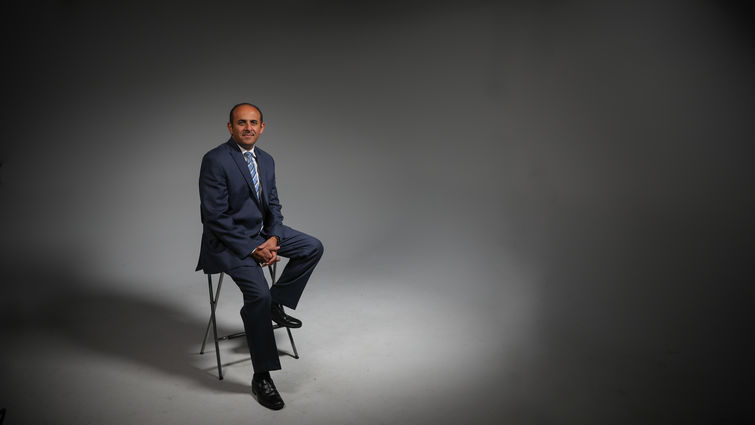
This story first appeared in Scope magazine.
Unlike most high school freshman, Ihab Dorotta, MD, spent the summer after his ninth-grade year taking equivalency testing and preparing to become a medical doctor. By age 15, he was beginning medical school in Alexandria, Egypt. He graduated at 22 and two years later began a residency at the Cleveland Clinic Foundation, where he served as the chief resident for the anesthesia department. After completing a fellowship, Dorotta came to Loma Linda University Health to work in critical care. In 2017, he accepted the position of chief of quality and patient safety.
“I’ve had quite the journey to where I am today,” Dorotta says. “I learned a lot along the way, and I’m thankful to be able to use those many lessons to help our community — especially in a time like this.”
Since taking the role in 2017, Dorotta has helped the institution navigate one of the worst flu seasons of the past decade and applied that same knowledge to address COVID-19.
1. What falls under the role of a quality and patient safety officer?
Quality and patient safety are two distinct sciences. Patient safety refers to making sure patients do not acquire complications because of errors. Quality refers to maintaining positive clinical outcomes, patient experience, productivity, efficiency and process reliability.
For safety issues, we meet together in a multidisciplinary team to discuss any problems and do a root cause analysis to discover the contributing factors and create action plans necessary to mitigate that risk in the future.
On the other hand, quality is maintained by setting up systems and processes from the bottom up that will ensure we not only maintain patient safety but that the choices we make — whether diagnostic or therapeutic — are in the patient’s best interest and lead to good outcomes.
2. How do you respond to the new challenges in patient safety?
First, someone in quality and patient safety needs to be agile and flexible with the ever-changing information from regulatory bodies — the county, the state and the federal government.
There’s an urgency in reviewing the ever-changing information and to then articulate why we are doing what we’re doing. The caution to not try new treatments before seeing scientific evidence has shown to be overall beneficial to our patients. We’ve been intentional about balancing evidence-based medicine and being early adopters of therapies that could provide promise and extra protection for our workforce. Loma Linda University Health has a long history of innovation, and even amid the new challenges, we’ve been able to research new therapies and medications to benefit our patients.
3. How could action be better than inaction in some cases?
In some circumstances, you want to be an early adopter. Our organization was the earliest adopter of universal masking — or giving everybody on-site a surgical mask. We were also quick to provide N95 masks to all providers caring for COVID-19- positive patients.
In other situations, you want to defer action — but that doesn’t mean doing nothing. Our institution has worked to provide a more proven therapies, not just to the local community but to the nation. Our research teams have been hard at work to not only import the latest evidence-based medicine, but to export it as well.
We’ve worked hard to make sure treatments are tested and proven beneficial before we potentially begin using them. Physicians know it’s vital to research new therapies and drugs, but in this crisis environment, we want to be early adopters of promising therapies that could save lives if they don’t put the patient at any additional risk.
And as crucial as quick action is, in some cases, waiting can also benefit the patient. The decision not to use a treatment that may be dangerous but may help a patient keeps me up at night. It’s hard to tell physicians who deeply care to hold back from offering every aggressive therapy, but in some cases, we see months later that inaction was the best action.
4. How have you seen the early action of the organization pay off?
We used the collective wisdom of our clinical leadership team to decide on the best course of action. Closing the hospitals to visitors, making sure we got the resources we would need, and reaching out to new sources to ensure we had enough PPE, were all early steps we took to ensure we were protected. Non-clinical departments like Philanthropy worked to get donations of face masks and food. With all of us getting together, there was a strong spirit of innovation.
The proactive planning to separate COVID-19 patients was also something that significantly limited workforce exposure. We specified some units where we could geographically cohort all our COVID-19 positive patients. We had providers from our ICU, acute care, and Emergency Department who stepped up to provide care for those patients. Since those patients were separated relatively early, the exposure of our broader workforce was limited.
5. How have people other than leaders responded?
Many people outside of the COVID-19 units also jumped into action, making homemade masks, 3D printed face shields, copperhead metal frames for intubation, the plexiglass hood for intubation, and more. Our information technology teams also worked tirelessly to ensure our patients' safety and comfort as we leaned on telehealth services to continue serving out patients. Each department stepped up to meet the challenges head on.
I think it speaks to human behavior. When some of us are faced with a problem, we look for solutions. I am incredibly proud to be part of an organization where people are exceptionally innovative in their approach to a stressful situation.
